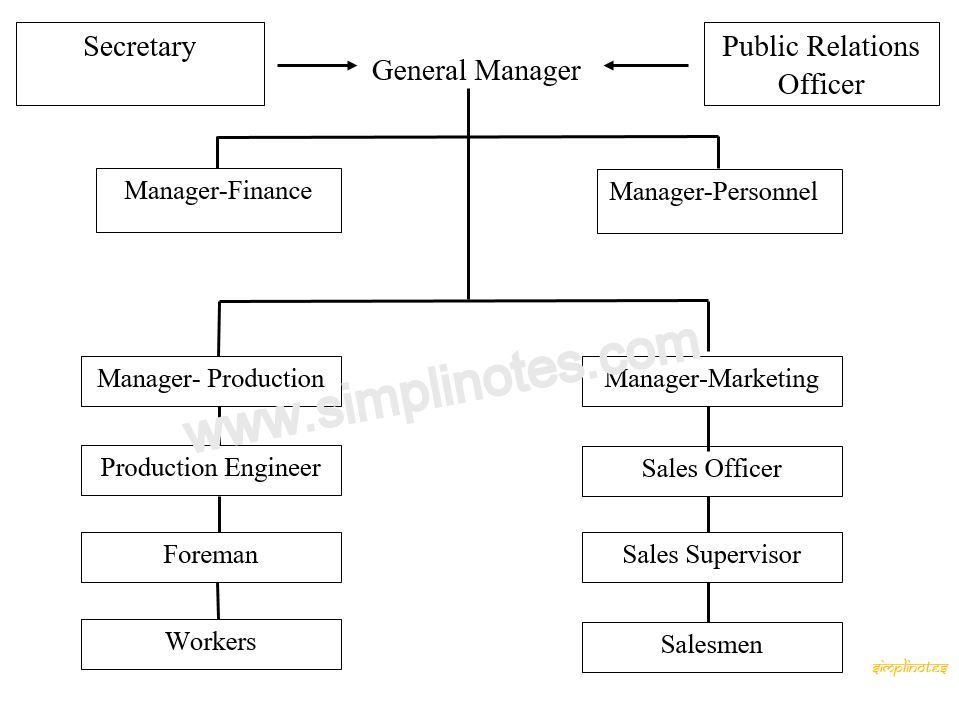(b) Line and Staff Organization
Line and staff organization refers to a pattern in which staff specialists advise managers to perform their duties. The line department is the one which perform activities that are substantive (direct) in the contribution to the organization’s overall objectives whereas staff department is the one which perform activities that are objective and indirectly contributes to the organization’s overall objectives. Because of these two types of departments, there can be two types of authority in the organization: line authority and staff authority. Different types of relationships thus, exist in the organization. If the classification of activities is taken at departmental levels, this type of relationship may be found among various positions within various departments.
Line relationship
Line managers have a clearly-defined role to play in the organization which requires understanding of the nature of line authority and of the line relationship. In the organizing process, starting for the top, the activities are assigned to individuals making them responsible for the proper performance of the activities. Authority is delegated to these individuals to perform the functions. These individuals, in turn, assign some of the activities to persons below them in the hierarchy. This process of assigning activities and delegating authority creates superior-subordinate relationships throughout the organization. The direct relationship between a superior and his subordinates is created by the force of line authority and this relationship is called as line relationship. Such relationship exists in line as well as in staff departments.
Staff Relationship
The nature of staff relationship is purely advisory. Though the staff personnel exercise line authority over the subordinates of their own department, they do not have any other line authority. They provide advice, assistance, and information upwards, and it depends upon the line managers where these are put into action or not. Thus, accepting of an advice from a staff officer by a line manager is not obligatory. However, since the staff personnel are specialists in their area, there is a likelihood that their advice gets acceptance by line personnel and is put into action. This gives additional weight to staff personnel. The staff authority flows upwards. An advice tendered to a line manager becomes order, obligatory to be obeyed. If he exercises line authority over his subordinate for putting the advice into action. This relationship is clear from the following diagram. The positions and departments in rectangles are staff and others are line. These staff specialists may provide services to a particular position, department or organization as a whole.
The line authority flows downward and staff authority flows upward. The general manager exercises the authority over his subordinates- all the functional managers both heading line and staff departments. Staff managers render advice about the problems in their respective areas to the general manager who gives order to his subordinates concerned to put advice into action. However, staff manager e.g. personnel manager has line authority over his subordinate (personnel officer).
Merits
i. Planned Specialization
The line and staff structure is based upon the principle of specialization. The line managers are responsible for operations contributing directly to the achievement of organizational objectives whereas staff people are there to provide expert advice on the matters of their concerns. This there is ample chance for creative thinking for generating new ideas and actions, which are quite important for the organizations.
ii. Quality Decisions
The quality of decisions in line and staff structure is high because the decisions come after careful consideration and thought. Each gives his advice in the area of his specialization which is reflected in the decisions.
iii. Prospect for Personnel Growth
This system of organizing offers ample prospect for efficient personnel to grown in the organization. Not all that, it also offers opportunity for concentrating in a particular area, thereby increasing personal efficiency. This is also according to the personal linking, that is , one os expected to work better in one’s main discipline.
iv. Training ground for Personnel
It provides training ground to the personnel in two ways.
(a) Since everybody is expected to concentrate on one field, one’s training needs can easily be identified.
(b) The staff with expert knowledge provides opportunities to the line managers for adopting rational multi-dimensional approach towards a problem.
Thus, by observing how staff people look at and solve a particular problem, line managers themselves sharpen their diagnostic and problem-solving abilities. Thus, they easily take the total view of the organizational functioning.
Demerits
i. Lack of well-defined Authority
Though it is easy to say about line and staff authority, often in practice, it become difficult to differentiate clearly between line and staff because, in actual practice, the authority is often diffused. Thus, the managers may not be clear as to what is expected of them or what is the actual area of the operation of their authority. Thus, confusion may be created in the organization.
ii. Line and Staff Conflict
The main problem of line and staff structure is the conflict between line and staff managers. Such conflict may be because of various reasons and sometimes the organizational conflict may be taken as personal conflict resulting into interpersonal problems.

